Geoanalytics is a form of data visualization that contextualizes your data and uncovers insights through geographic location.
The term “geoanalytics” is just one of many used to describe location-based data analysis. Other names for it include location intelligence, geolocation, geo (or geographic) analysis, geospatial analysis, CRM (Customer Relationship Management) mapping…the list goes on.
They all achieve the same purpose, though: applying geography to your business processes to uncover analytical insights.
Geoanalytics is sort of like adding another dimension to your data analysis – it adds the location element to provide you with another way to display and analyze your data.
Put simply, geoanalytics gives you a new, visual perspective. After all, decision makers don’t need more data, just a better way to interpret what they already have.
This is the problem geoanalytics is made to solve. It helps you uncover location-based insights by layering your CRM data on maps.
In this guide, we’ll answer all the questions you could possibly have about geoanalytics and location intelligence. You’ll learn everything you need to know, specifically:
Geoanalytics can be used in different ways, including CRM mapping for businesses. It location-enables your CRM to help you geographically visualize your accounts, contacts, opportunities, and any other CRM data – but how?
It begins by layering sets of data on a map so you can compare and contrast based on geographic boundaries. With geoanalytics, you can locate and map data anywhere in the world. This visual representation of data makes it easier for the brain to digest and interpret the information.
Integrating geography with business analytics like this gives you geoanalytics.
When your records are displayed on a map like this, it shows you the big picture. Patterns and trends become more clear, particularly when you use some of the advanced filtering and visualization techniques that accompany geoanalytics.
The map adds an extra dimension that list views and reports are lacking: a geographic understanding of where your records are and how they relate to each other in proximity.
Further, there are many components or capabilities that make up geoanalytics, and their purposes vary from analysis to management and visualization.
Location intelligence increases the value of your CRM data. More than just adding data points to a map, geoanalytics technology helps you aggregate and analyze location and business data to solve challenges and achieve business goals.
To maximize the value of your CRM data, it’s important that your data analytics tools include the following location intelligence capabilities:
Geoanalytics capabilities include advanced visualization and filtering that help you identify trends and patterns. Multiple search types and filtering options make your results tell a story instantly. Searches can be performed that show a view of all accounts clustered by concentrations near a particular location, within the boundaries of a territory, or over a broader area.
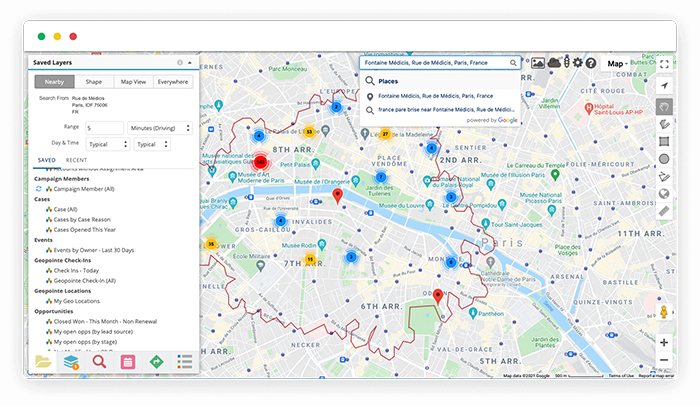
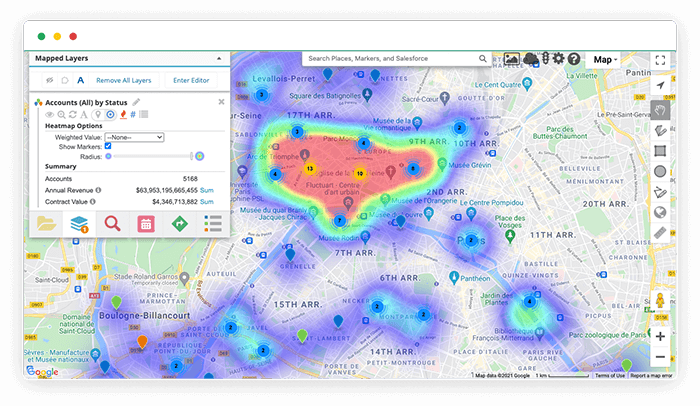
Marker clustering and heat mapping reveal insight about gaps, trends or ideal target locations to inform your business strategy. View data based on record count or any numeric record field such as opportunity size, annual revenue, or employees. It is displayed across the map with color-coded areas showing concentrations of records or markers representing records in an area.
Geoanalytics helps with territory design and management. Instead of using spreadsheets and reports to understand something as visual as sales territories, throw up records on a map to analyze the different areas your sales reps own. It’s easy to make adjustments right from the map to ensure territories are balanced, or reassign accounts to a new territory as your sales team expands.
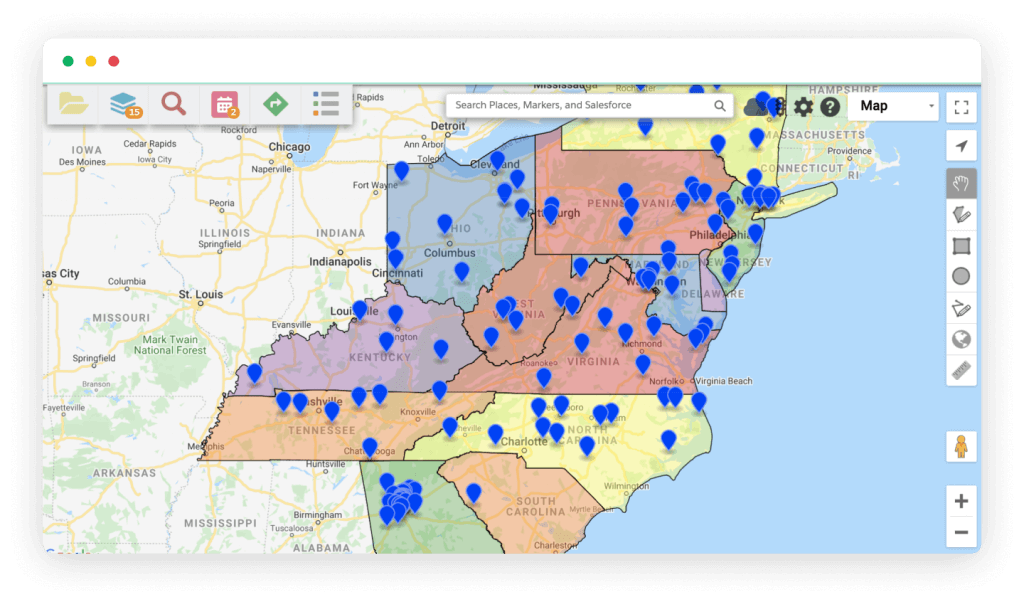
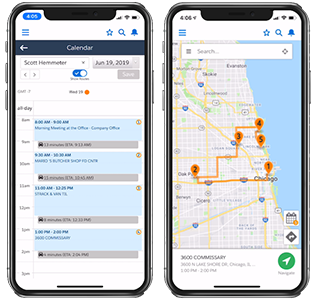
Geoanalytics allows you to map and optimize your travel plans based on the accounts or customers you plan to visit. Build a route with the accounts you prioritize and access it when you’re on the road, even filling in last minute cancelations with nearby accounts. Geoanalytics helps save you time & money by uncovering the most efficient route possible, but also allows for maximum flexibility in your scheduling.
Thematic map layers allow you to roll up metrics (such as record count or dollar amount) to group and color code data sets by geographic boundaries. Unlike heat maps, thematic layers allow you to see concentrations delineated by boundaries you set, not just hot spots. This helps condense large amounts of data for quick understanding.
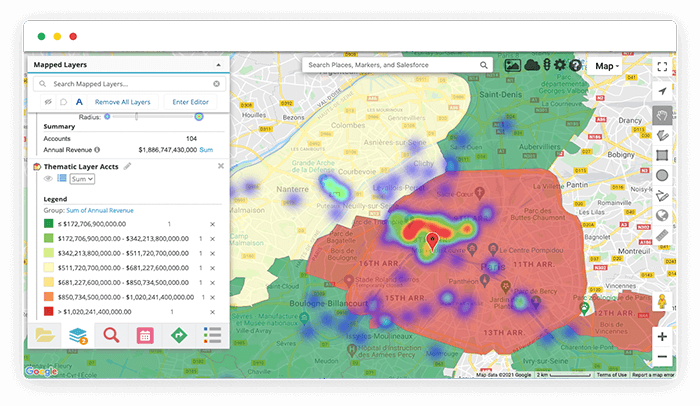
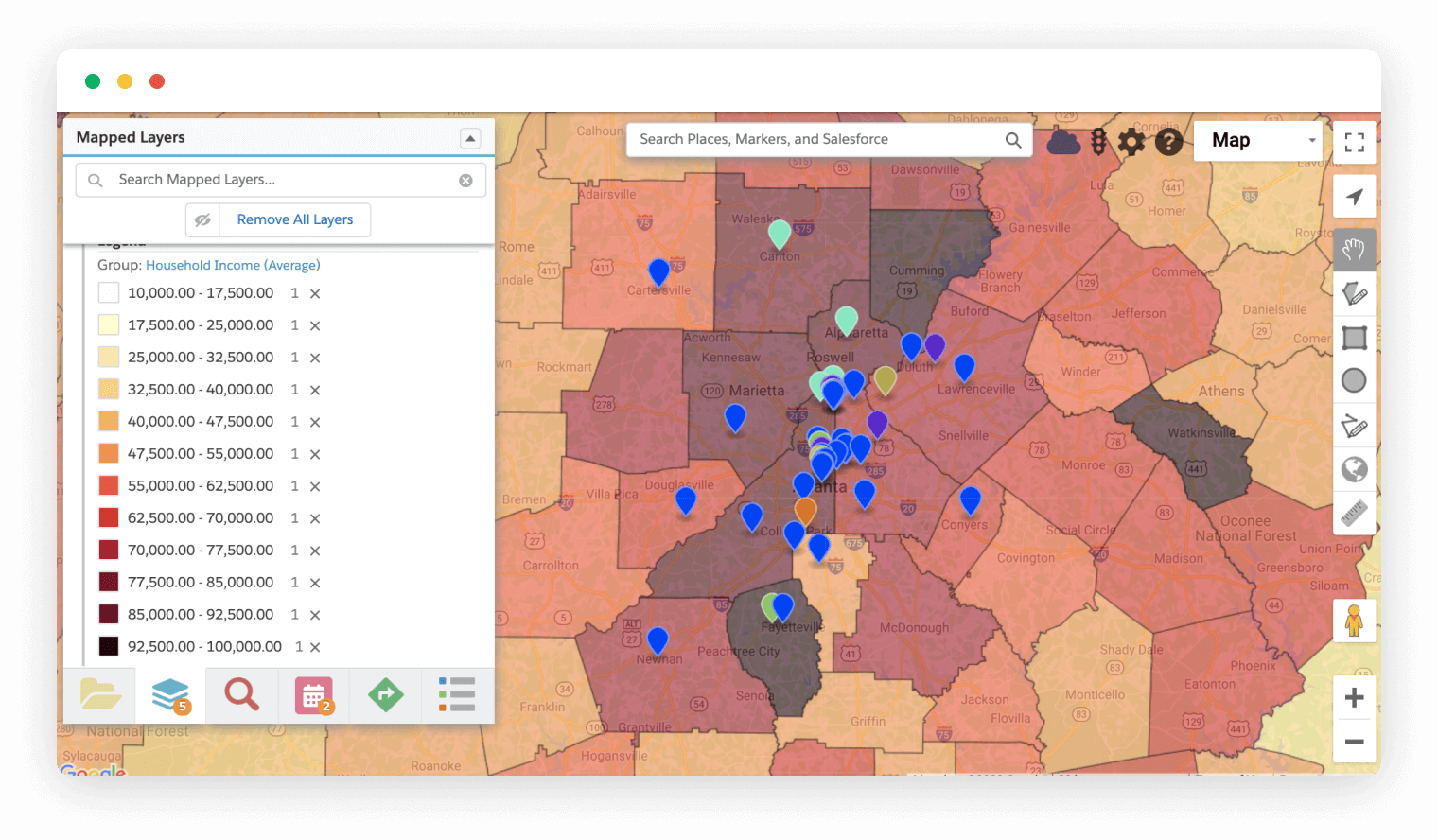
Data sets are the building blocks of most geoanalytics solutions. The data sets that can be used vary – use demographic layers to uncover deeper insight into your customers and accounts, or import any other data with location information via CSV layers to analyze whatever you want.
Ok, now you understand what geoanalytics is – but you’re probably wondering, “Why is geoanalytics important?” Let us explain.
Geoanalytics is important because of the new perspective it brings to your data. Particularly when it comes to CRM data, reports and dashboards just aren’t enough to truly surface the actionable insights you need. Geoanalytics takes the data you have in your CRM and displays it on a map, making it easier to understand and gain actionable insights that will help you make better decisions.
Geoanalytics also saves you time. Time is the most valuable resource, so wasting it trying to interpret data in spreadsheets and tables isn’t ideal. That’s where geoanalytics comes in – the visualization it provides sparks instant comprehension.
Sure, you could use spreadsheets filled with thousands of data points and eventually come up with some insights. But with geoanalytics, you can look at a map and instantly see the patterns and understand what the data is telling you. One way to think of geoanalytics’ advanced analysis and search capabilities is to imagine the filtering capabilities you have in a list view combined with the complex possibilities of a report.
Because geoanalytics helps you stay organized tactically, you’ll be able to quickly increase your efficiency and streamline your processes. Further, with the insights gained from geoanalytics you’ll be able to make better decisions when it comes to your business.
Understand what your data is telling you instantly and see the big picture. Your data and insights are all there in your CRM, you just can’t see them yet – geoanalytics surfaces those insights, providing you with a lens through which you can visualize your data.
The ability to interact with a map, performing actions like exporting or adding to a campaign, is built-in with geoanalytics. There is so much more to it than just looking at a map; you can work with your CRM data as it’s displayed visually to make adjustments & changes.
Whether you’re planning and optimizing routes, balancing your team’s territories, or analyzing the data in your CRM, geoanalytics exponentially increases your productivity and efficiency. Get back hours of time in your day, streamline processes, and optimize your travel to be more cost-effective and simple.
As you now know, geoanalytics is a powerful form of data visualization that combines geographic location with traditional data analysis. This extra dimension allows for comparisons and instant understanding of complex relationships in your CRM records, something that is valuable to any business.
Do you ever find yourself frustrated because, “There’s no easy way for me to do _____ in my CRM?” If so, you’re not alone. Pick any organization and you’ll find someone who has had this thought as well. It might just be something different depending on the work they perform on a daily basis.
The best way to understand the use cases for geoanalytics at a more granular level is to narrow down by industry or job role. Read on for specific examples of these use cases.
The beauty of geoanalytics is it can be used in a variety of industries, and by a variety of roles – as long as you have a CRM and location-related data. Some of the main industries that use geoanalytics include:
Geoanalytics allows financial service organizations to visualize concentrations of policies, optimize scheduling and routes to client meetings, and easily track AUM. Companies can provide the best customer experience possible with the added benefits that location insights bring to your CRM.
Geoanalytics helps the healthcare industry improve everything from patient care to operational workflows. Healthcare organizations can optimize product distribution and make medical device sales routes more efficient to reduce cost and deliver the best solutions possible.
Manufacturing supply chain processes benefit from geoanalytics by improving workflows with geolocation-based insights and performance tracking. It gives companies the ability to visualize their CRM data by showing customers, suppliers, orders, and deliveries on the map.
One of the biggest challenges telecommunications companies face is the high volume of data this industry uploads into their CRM. It quickly becomes overwhelming and impossible to sort through all that data when you’re talking about millions of records, unless you have a way to visualize it.
Optimizing door-to-door sales and service routes is easy for Telecommunications companies that use geoanalytics. Organizations are able to be more efficient, reducing cost and delivering the best service possible.

Use geoanalytics or location intelligence to determine which accounts and prospects to prioritize based on CRM data such as revenue, company size, and more. Data sets, such as demographic layers, help you uncover deeper insight into your customers and accounts. Other capabilities like thematic maps and heat maps will tell you a story about where the money is – which regions are more important to contact first?
Some geoanalytics solutions also integrate with your calendar to allow for scheduling and viewing your schedule on a map. You can visualize scheduled calls for the future, and the interactive map enables you to update appointments quickly should anything come up.
Identify where your targets reside on the map, then use route optimization to create more efficient routes, allowing you to visit more clients per day. Make your trip as productive as possible with travel planning and route optimization.
Increase efficiency, preparedness and productivity with critical information at your fingertips. Customized ‘check-in’ forms help you keep track of visit notes on-the-go when the information is still top of mind, improving data accuracy. The nearby searching capabilities in some geoanalytics solutions enable you to fill in gaps caused by any last minute cancellations with nearby accounts.
Geoanalytics provides business leaders and executives with visual reporting using geolocation for an at-a-glance understanding of different aspects of your business. Visualize geographic trends in your CRM data on the map to help drive decisions that increase productivity.
Leaders can also easily keep track of sales reps’ schedules, filling in gaps with priority accounts based on who has availability with a Calendar-Based Scheduling solution found in some geoanalytics software. Easily design, analyze and reassign territories in order to distribute sales leads or service cases, then quickly update account ownership after analyzing whether your team’s territories are balanced properly.
Reveal business insights and visualize your CRM data using geoanalytics. The map adds an extra dimension a list view or report cannot: a geographic understanding of where your records are and how they relate to each other in proximity. Design territories for optimal coverage, streamline updates with mass edits within the map and even automate assignments and actions based upon geography.
Map your data to provide context; tasks & processes such as data management are made easier with visualization tools. If you have thousands of records, throw them up on the map to make the data easier to analyze with advanced filtering capabilities. Easily identify geographic concentrations of open or closed opportunities and use these insights to strategize about where to focus future efforts.
Build stronger relationships and gain deeper customer insight while ensuring your accounts receive the service and attention they need. Filter based on activities in a customer’s interaction history, or date of upcoming renewal contract, all while visualizing this more abstract data on a map. See where accounts and contacts are concentrated for valuable insight into your customers.
The powerful filtering capabilities that geoanalytics provides make large volumes of data more manageable. Clustering is essential for simplifying your view of markers on the map when you have thousands of records or data points. Heat maps take data visualization and aggregation a step further, so you can easily narrow down the focus to your most important customers when prioritization is necessary.
Visualize where your customers, prospects, and accounts are located and build campaigns to target them using location intelligence. Find the right venue for customer appreciation and marketing events by searching within a geographic radius for customers with specific criteria. Prepare for trade shows by reaching out to contacts located near an upcoming event, then personalize and segment your promotional content geographically.
Rethink how you use campaign results to strategize your next move. With geoanalytics, you can geographically layer data such as trade show leads, opportunities opened, and industry to achieve higher ROI.
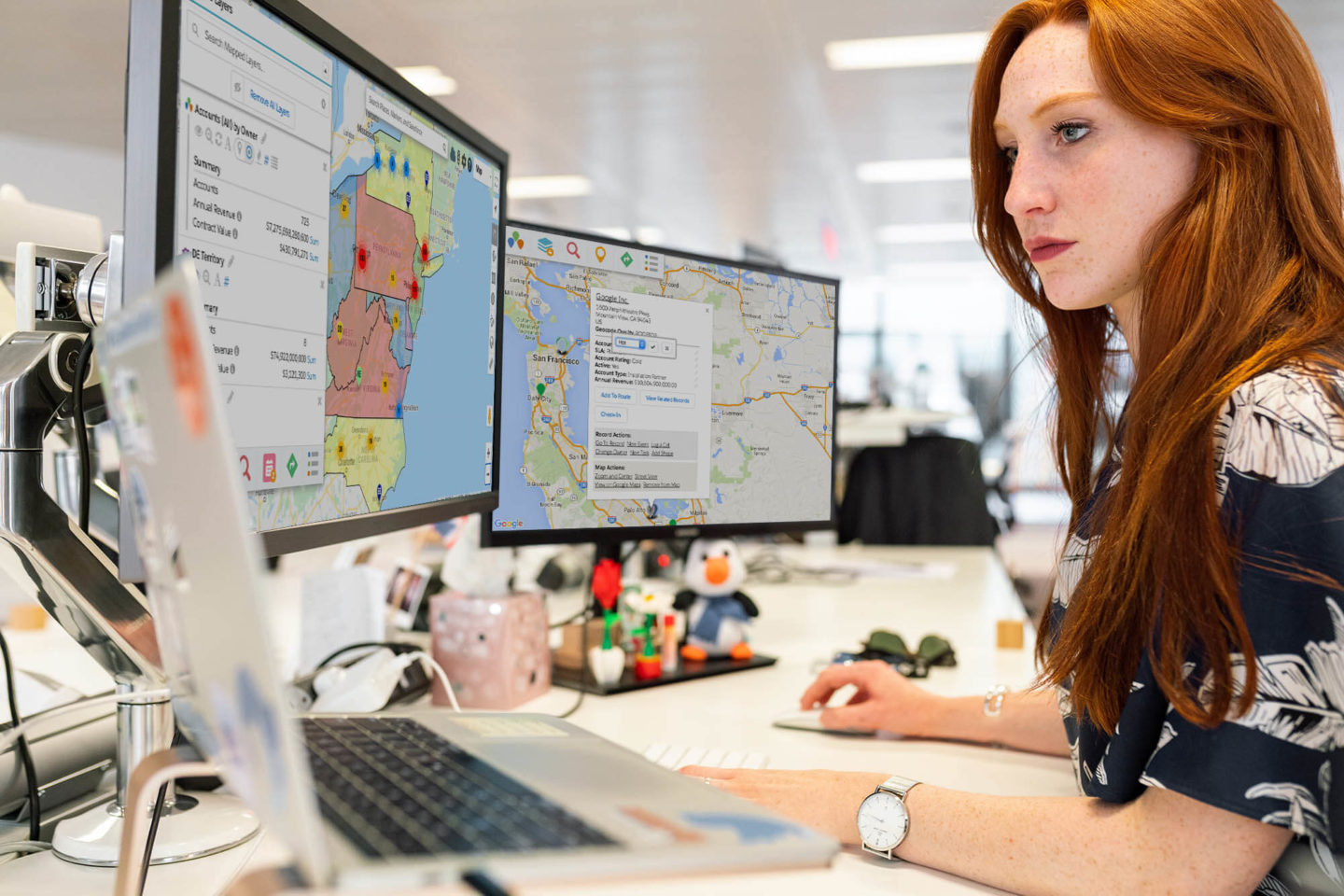
This ability to visualize data and understand its relation to any other given location in the world is incredibly useful and compelling.
With standard data analysis tools, CRM data is often broken down into graphs, charts, lists, and other tabular formats that attempt to provide clear insights. However, these other tools are missing the “where” in your data that connects it with a physical location.
Geoanalytics provides new context and perspective to data that is simply not possible with reports and spreadsheets. Maps and spatial data can immediately help users discover new insights and communicate more effectively with co-workers and customers.